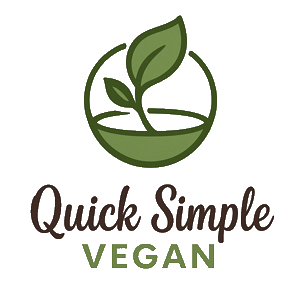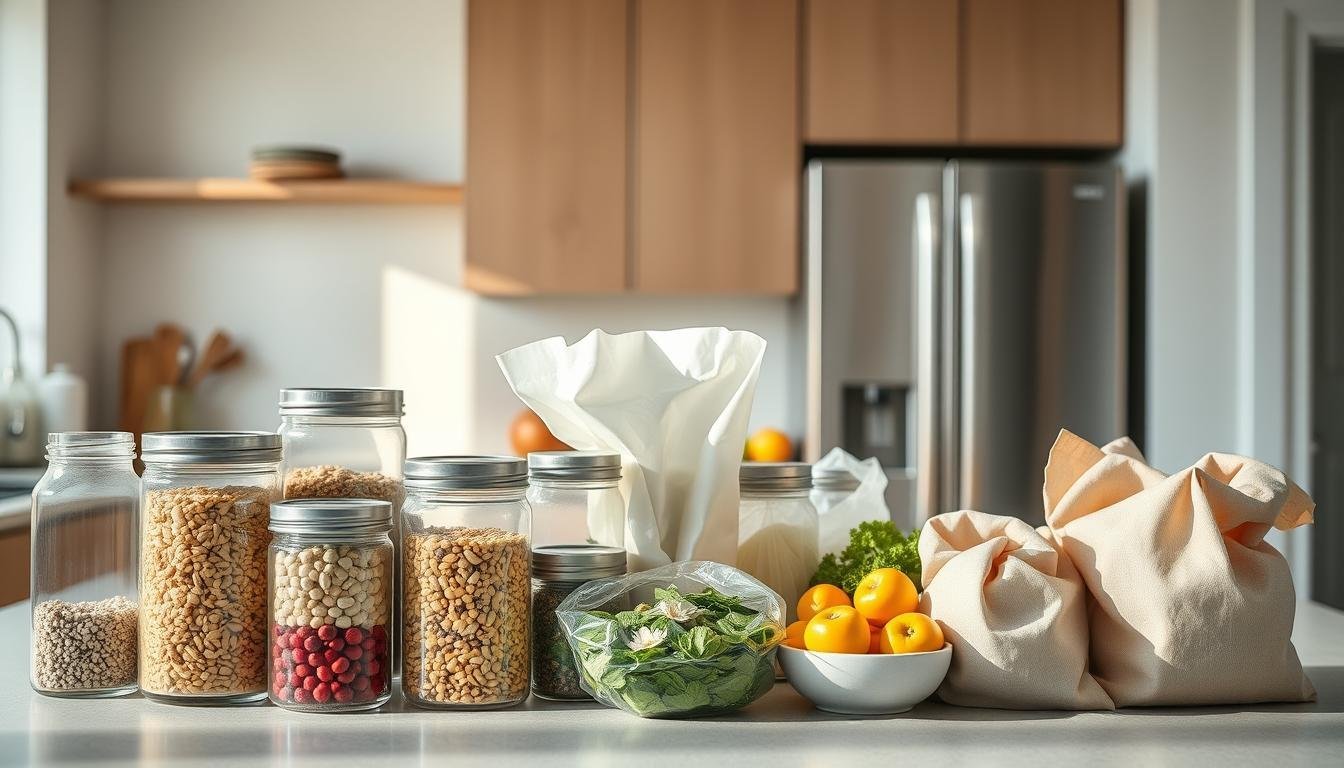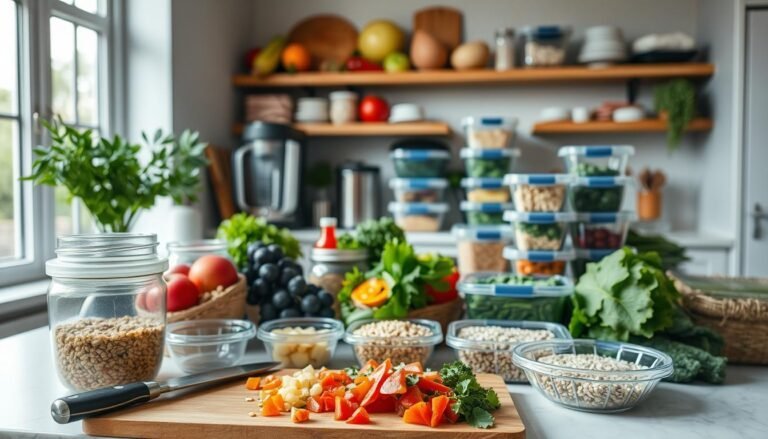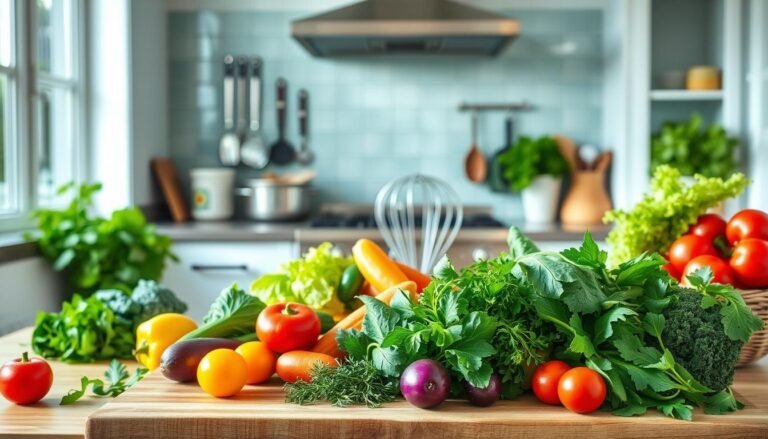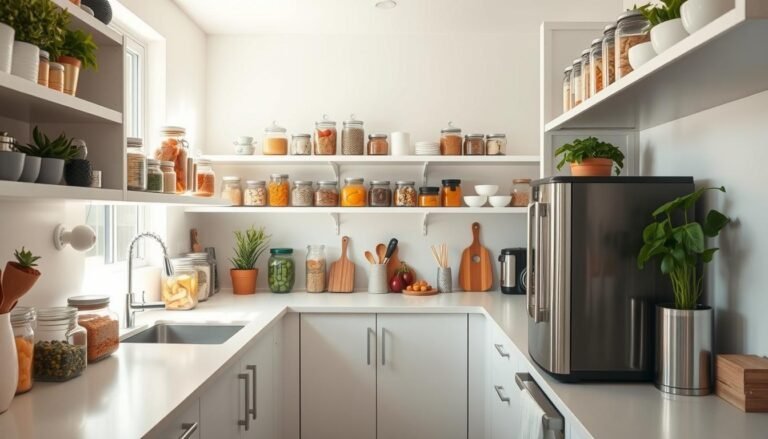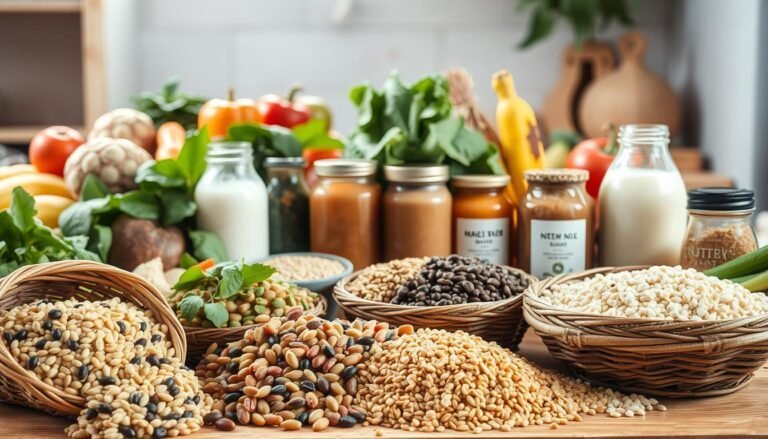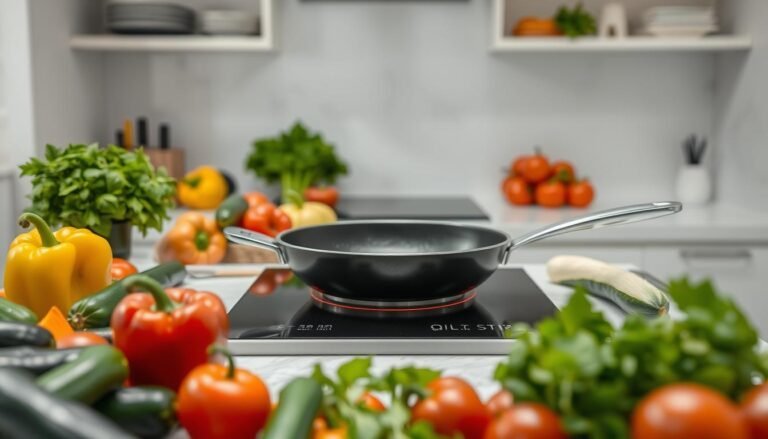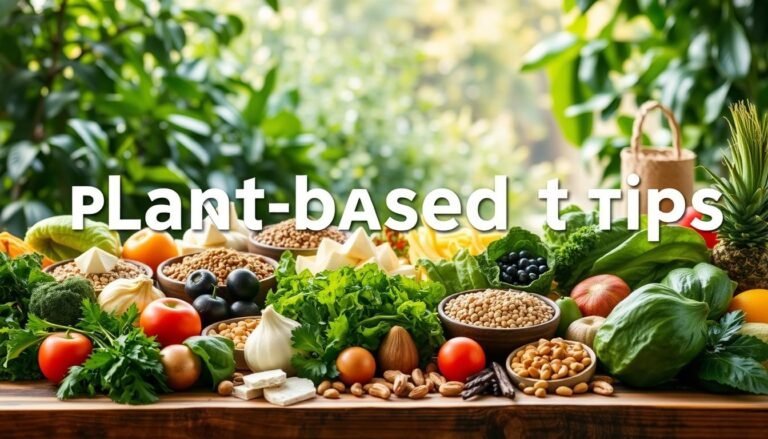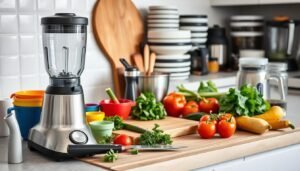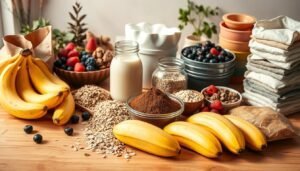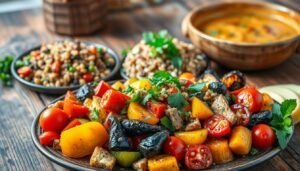Disclosure: This Post Contains Affiliate Links; We earn a commission on purchases.
Starting a vegan lifestyle means you need to plan well, including how you store and prepare food. Proper storage techniques are key to keeping vegan foods fresh and full of nutrients.
Freezing is a great way to keep many vegan foods fresh, like fruits, veggies, and even meals. Knowing how to freeze foods right can cut down on waste and make meal prep easier.
With good storage and freezing tips, vegans can enjoy a wide variety of healthy meals. This also helps reduce harm to the environment.
Key Takeaways
- Understand the importance of proper food storage for vegans.
- Learn effective techniques for freezing vegan foods.
- Discover how meal prep can simplify vegan cooking.
- Explore the benefits of reducing food waste through proper storage.
- Find out how to maintain the nutritional value of frozen vegan foods.
The Fundamentals of Vegan Food Storage
Learning about vegan food storage is key to keeping plant-based foods fresh. The right storage methods keep food fresh and full of nutrients. It also helps cut down on food waste.
Understanding Shelf Life of Plant-Based Foods
The shelf life of plant-based foods changes a lot. It depends on the food type, storage, and how it’s handled. For example, leafy greens spoil faster than root veggies. Knowing how to store each vegan food helps it last longer.
- Check expiration dates and “use by” labels.
- Store foods in their original packaging or transfer them to airtight containers.
- Keep track of storage conditions, such as temperature and humidity.
Essential Storage Equipment for Vegans
Having the right storage tools is important for keeping vegan foods good. You’ll need:
- Airtight containers for grains, legumes, and snacks.
- Glass jars for storing oils, vinegars, and condiments.
- Reusable bags for produce and bulk items.
Buying good storage containers helps a lot in keeping vegan foods fresh.
Food Safety Considerations for Plant-Based Diets
Food safety is very important when storing vegan foods. To avoid spoilage and illness, remember to:
- Keep your storage area clean and organized.
- Check storage temperatures; most vegan foods need to be kept below 40°F (4°C).
- Watch out for cross-contamination, which is a big risk when storing different foods together.
By knowing how long plant-based foods last, using the right storage tools, and following food safety rules, vegans can enjoy lots of fresh, healthy foods. This also helps reduce waste.
Complete Guide to Storing and Freezing Vegan Foods
Learning how to store and freeze vegan foods is key for a healthy diet. The right storage keeps plant-based foods tasty and nutritious. This way, your vegan meals stay delicious and fresh.
Refrigeration Best Practices for Fresh Produce
To keep your produce fresh, store it right in the fridge. Here are some tips:
- Store fruits and veggies in separate spots to avoid moisture damage.
- Keep your fridge at a steady 40°F (4°C) to slow down bacteria.
- Use bags or containers that breathe to keep humidity right and stop ethylene gas buildup.
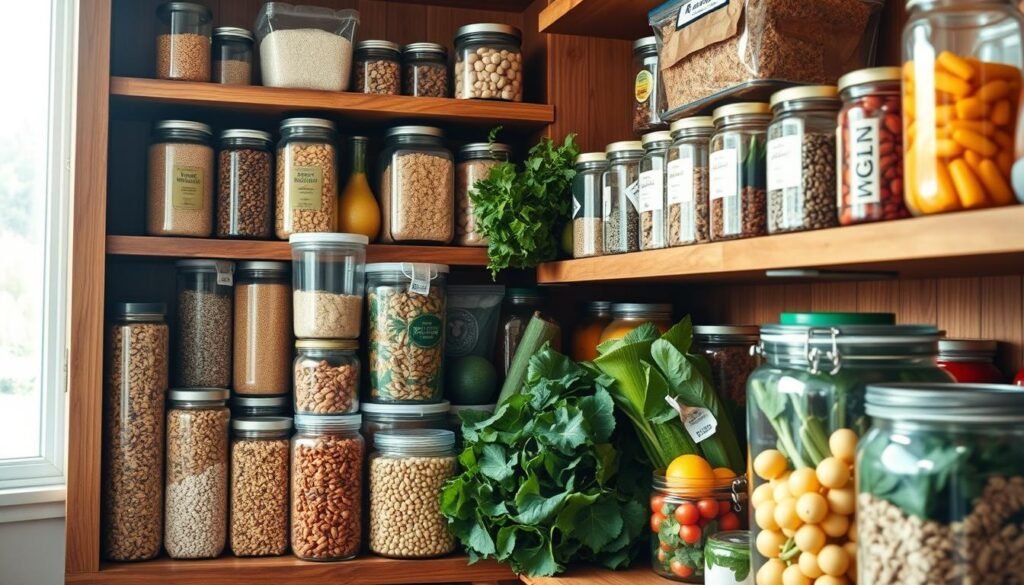
Pantry Organization for Vegan Staples
Organizing your pantry keeps your kitchen tidy and efficient. Here are some tips:
- Use airtight containers for grains, legumes, and nuts to keep them fresh and pest-free.
- Label containers clearly so you can quickly find what’s inside.
- Use the “first-in, first-out” rule to eat older items before they expire.
Preventing Spoilage and Maximizing Freshness
To avoid spoilage and keep foods fresh, check them often. Here are some tips:
- Regularly inspect stored foods for mold, sliminess, or bad smells.
- Use up older items first and freeze foods near expiration.
- Keep storage areas clean and dry to stop bacteria and mold growth.
By following these tips, you can enjoy a variety of fresh, tasty vegan meals. This reduces waste and keeps your kitchen sustainable.
Freezing Techniques for Different Vegan Food Categories
Freezing is key for keeping vegan ingredients fresh all year. Each type of vegan food needs a special way to freeze. This keeps their quality and nutrients good.
Fruits and Vegetables: Preparation and Freezing Methods
When freezing fruits and veggies, start with washing and peeling. Chop them into sizes you like. For many, blanching stops enzymes that spoil food.
Blanching Techniques for Optimal Results
Blanching means quickly boiling or steaming veggies. It stops enzymes and keeps color, texture, and nutrients. Broccoli and green beans do well with blanching before freezing.
Flash Freezing to Prevent Clumping
Flash freezing freezes food fast to stop clumping. It’s great for berries and peas. Spread them on a baking sheet, freeze, then bag them up.
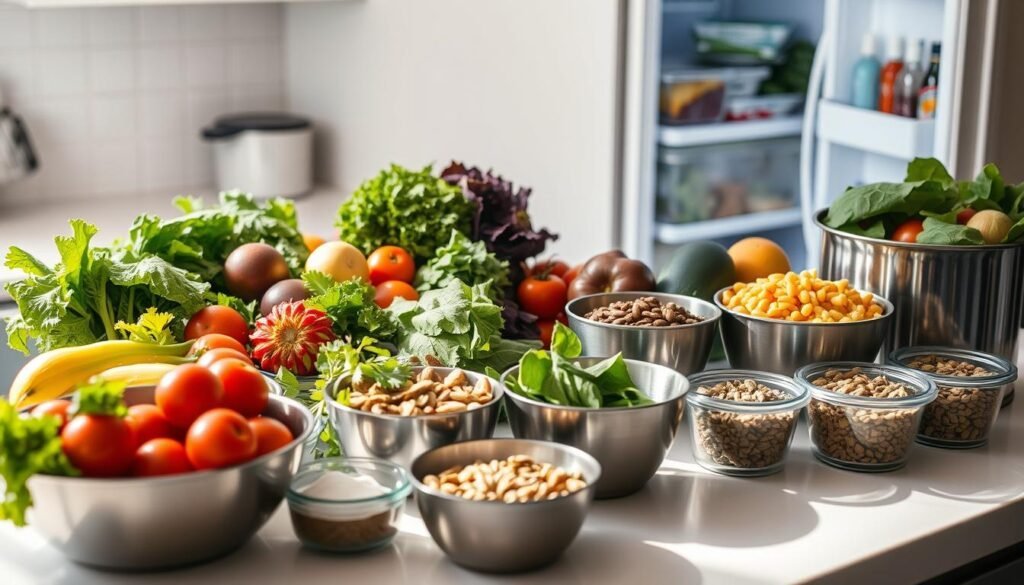
Plant-Based Proteins: Tofu, Tempeh, and Seitan
Freezing tofu, tempeh, and seitan needs thought. Tofu can be frozen whole or cubed, but drain it first. Wrap tempeh and seitan tightly to avoid freezer burn.
Vegan Dairy Alternatives and Their Freezing Properties
Vegan milks and yogurts freeze differently. Some separate when thawed, others stay the same. Always check the product’s instructions. Homemade yogurts can freeze, but thawing changes their texture.
Freezing Vegan Baked Goods and Desserts
Vegan treats like muffins, cakes, and cookies freeze well. Wrap them up or store in airtight containers. You can also freeze dough for later baking.
Freezing the right way lets vegans enjoy a wide variety of foods all year. It helps reduce waste and keeps nutrients in.
Vegan Meal Prep: Batch Cooking and Freezer Organization
Effective vegan meal prep is a big help for those living plant-based. It saves time and keeps healthy meals ready to go.
Planning and Preparing Freezer-Friendly Vegan Meals
First, plan meals with what’s in season and what you already have. Make a meal calendar to organize your cooking. This way, you won’t waste ingredients.
Choose meals that freeze well, like soups, stews, and casseroles. This makes meal prep easier.
Use ingredients that keep their taste and texture when frozen. For example, vegan chili with beans and veggies freezes great.
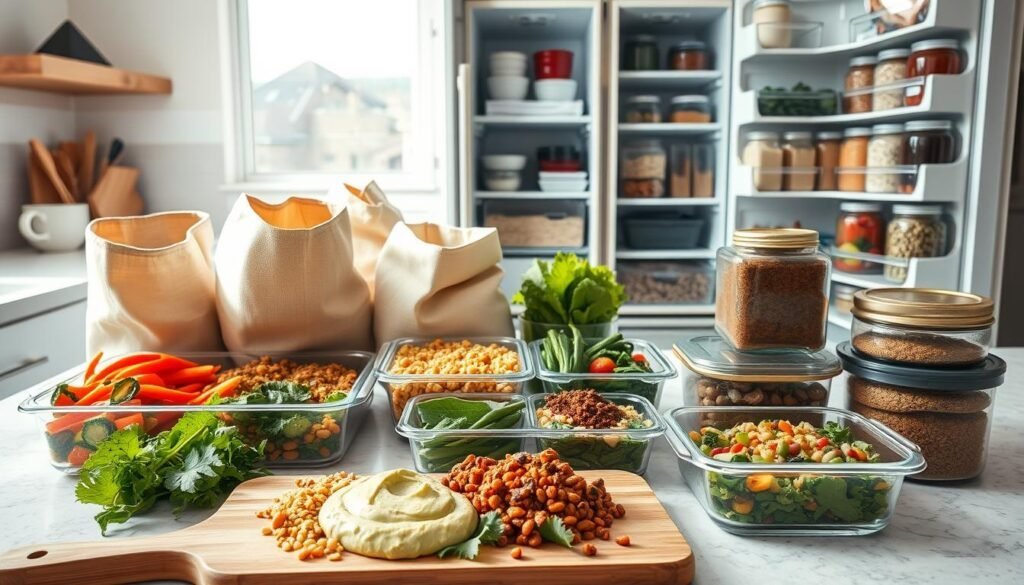
Proper Containers and Packaging Methods
The right containers are key for keeping frozen meals fresh. Use airtight, freezer-safe containers or bags to avoid freezer burn. Glass containers are also good for freezing and reheating.
Labeling and Rotation Systems for Frozen Foods
Use a labeling system with dates and meal names. This helps you use older meals first and avoid waste.
Thawing and Reheating Plant-Based Meals Safely
When reheating, follow safe thawing and reheating practices. Thaw in the fridge or cold water. Reheat to 165°F (74°C) for safety.
By doing this, you can enjoy tasty, plant-based meals. You’ll also save time and reduce waste.
Effective Vegan Food Storage for a Sustainable Kitchen
Storing and freezing vegan foods right is key for a tidy and green kitchen. Learning about vegan food storage and using the tips in this Guide to Storing and Freezing Vegan Foods helps a lot. It cuts down on food waste and keeps your plant-based diet healthy.
Good plant-based food preservation saves time and money. It also keeps vegan meals fresh and safe. With these tips, vegans can enjoy tasty, healthy meals and help the planet.
FAQ
How long can I store vegan staples like grains and legumes?
Can I freeze all types of fruits and vegetables?
How do I prevent freezer burn when storing vegan meals?
Can I freeze vegan dairy alternatives like almond milk and soy yogurt?
How do I safely thaw and reheat frozen vegan meals?
What are the best containers for storing and freezing vegan foods?
How can I maintain the quality of frozen vegan baked goods and desserts?

Focused on simplicity and flavor, Ryan helps readers create quick vegan meals and snacks without the overwhelm. Whether you’re new to vegan cooking or just want to keep it simple, Ryan’s tips, guides, and no-fuss approach make plant-based eating accessible and enjoyable for everyone.
Subscribe to Our Newsletter
